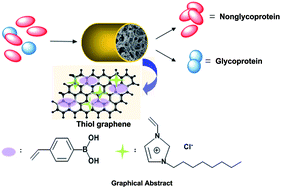Facile synthesis of graphene doped poly(ionic liquid) boronate affinity material for specific capture of glycoproteins†
Abstract
Glycoproteins, as low-abundance proteins in organisms, play a critical role in numerous biological processes such as signal transduction, cell differentiation, cellular adhesion, immune defense and embryonic development. Thus, the development of enrichment techniques for glycoproteins is of great importance. In this study, a thiol graphene (TG) doped poly[ionic liquid (ViOcIm+Cl−)] boronate affinity monolithic material was prepared in a single step. The recognition property of the resulting material was evaluated by capillary electrochromatography. The results indicated that the affinity material exhibited specific capture toward cis-diol-containing catechol and glycoproteins at buffer pH as low as 4.0, showing wide pH applications. The large specific surface area (133.64 m2 g−1) of the current monolithic material gave rise to high binding capacities (11.54 mg g−1 for ovalbumin and 10.82 mg g−1 for horseradish peroxidase). The practicability of the resulting monolithic material was further evaluated by specific recognition and enrichment of glycoproteins from egg white and human serum samples, demonstrating its potential for separation and enrichment of glycoproteins from complex biological samples.


 Please wait while we load your content...
Please wait while we load your content...